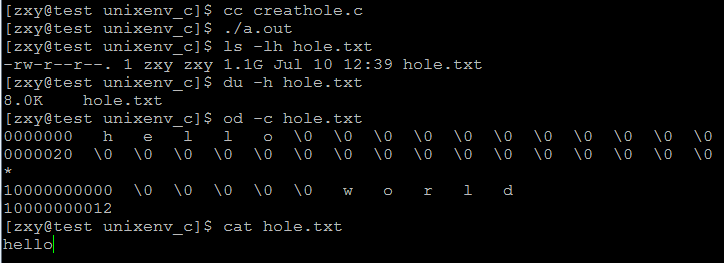一、lseek()系統呼叫
功能說明:
通過指定相對於開始位置、當前位置或末尾位置的位元組數來重定位 curp,這取決於 lseek() 函式中指定的位置
函式原型:
#include <sys/types.h>
#include <unistd.h>
off_t lseek(int fd, off_t offset, int whence);
引數說明:
fd:檔案描述符
offset:偏移量,該值可正可負,負值為向前移
whence:搜尋的起始位置,有三個選項:
(1).SEEK_SET: 當前位置為檔案的開頭,新位置為偏移量大小
(2).SEEK_CUR: 當前位置為檔案指標位置,新位置為當前位置加上偏移量大小
(3).SEEK_END: 當前位置為檔案結尾,新位置為偏移量大小
返回值:檔案新的偏移值
二、利用lseek()產生空洞檔案(hole)
說明:
The lseek() function allows the file offset to be set beyond the end of the file (but this does not change the size of the file). If data is later written at this point, subsequent reads of the data in the gap (a "hole") return null bytes ('\0') until data is actually written into the gap.
程式程式碼:
#include <stdio.h> #include <unistd.h> #include <fcntl.h> #include <stdlib.h> #define ERR_EXIT(m) \ do \ { \ perror(m); \ exit(EXIT_FAILURE); \ } while(0) int main(void) { int fd; int ret; fd = open("hole.txt",O_WRONLY|O_CREAT|O_TRUNC,0644); if(fd == -1) ERR_EXIT("open error"); write(fd,"hello",5); ret = lseek(fd,1024*1024*1024,SEEK_CUR); if(ret == -1) ERR_EXIT("lseek error"); write(fd,"world",5); close(fd); return 0; }
測試結果:
程式建立一個hole檔案,然後寫入”hello”字元,在利用lseek系統呼叫從當前位置偏移到1024*1024*1024之後再寫入”world”字元,ls顯示檔案大小為1.1G,實際上它並沒有佔用這麼多的磁碟空間,du表明hole檔案只有8k,系統只是儲存一些資訊,用它來表示有多少個\0,當我們用cat檢視檔案內容時只看到hello,由於檔案太大最後的world太后以致看不到,但當我們用od命令檢視時,可以發現有好多個\0。
